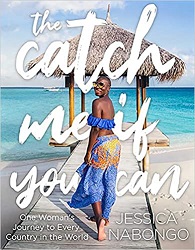Review of The Catch Me If You Can, by Jessica Nabongo
One Woman’s Journey to Every Country in the World
by Jessica Nabongo
National Geographic, 2022. 413 pages.
Review written February 11, 2023, from a library book.
Starred Review
This book is awesome!
Jessica Nabongo has traveled to all 195 United Nations-recognized countries in the world. In this book, she takes us along on that journey, complete with stunning photographs. She tells us about the people she met and the experiences she enjoyed.
Jessica is the first Black woman to officially achieve this milestone. I love her attitude of putting aside fear and looking for the good in every place in the world.
And oh my goodness, her outfits! She shows up in many of the pictures, wearing stunning outfits reflecting the location. The photography alone in this book makes it amazing, but combined with her stories, I was fascinated from start to finish.
My plan was to read about one country per day. Well, that was taking a long time, so I upped it to two or three countries per day. And yes, I renewed the book several times. But the dose of adventure and delight became a nice part of my routine.
Jessica’s Introduction is inspiring. Here are two of the lessons she learned:
I have visited the world’s 195 countries and 10 territories. Through these travels I learned two key lessons: First, most people are good. My journey was made possible by the kindness of strangers — some who opened their homes to me and others who donated money to help me reach the finish line. I do not know when we started to assume the worst in each other, but if you consider yourself to be a good person, why would you assume that a stranger is a bad one? I always assume the best of people because that is what I received nine times out of 10 in every corner of the world. The few bad experiences will never outweigh the good.
The second lesson I learned is that we are more similar than we are different. In the end, neither race, gender, social class, religion, sexual orientation, body type, education level, nor nationality make you better than the next person. The French philosopher Pierre Teilhard de Chardin said, “We are not human beings having a spiritual experience; we are spiritual beings having a human experience.” Once you fully accept that, you realize how much our differences simply do not matter.
I love her goal for the reader:
The intention of this book is not to convince you to travel to every country in the world, though it might. That was my dream. My intention is to show everyone — not just Black women and men, but all women and men — that your dreams are valid. Your dreams are achievable.
Let me encourage you to travel the world with Jessica Nabongo!
thecatchmeifyoucan.com
natgeo.com
Find this review on Sonderbooks at: www.sonderbooks.com/Nonfiction/catch_me_if_you_can.html
Disclosure: I am an Amazon Affiliate, and will earn a small percentage if you order a book on Amazon after clicking through from my site.
Disclaimer: I am a professional librarian, but the views expressed are solely my own, and in no way represent the official views of my employer or of any committee or group of which I am part.
What did you think of this book?









